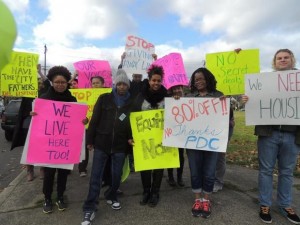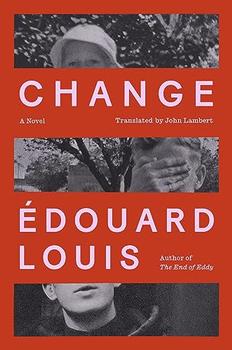Summary | Excerpt | Reading Guide | Reviews | Beyond the Book | Read-Alikes | Genres & Themes | Author Bio

Critics' Opinion:
Readers' Opinion:
First Published:
Apr 2021, 224 pages
Paperback:
May 2022, 224 pages
 Book Reviewed by:
Book Reviewed by:
Callum McLaughlin
Buy This Book
This article relates to The Night Always Comes
 In Willy Vlautin's novel, The Night Always Comes, a family in Portland, Oregan find themselves struggling to afford the cost of living in their neighborhood because of gentrification.
In Willy Vlautin's novel, The Night Always Comes, a family in Portland, Oregan find themselves struggling to afford the cost of living in their neighborhood because of gentrification.
Gentrification is the process in which wealthy individuals and businesses converge on a previously working-class or low-income neighborhood. (The word is derived from "gentry" and was coined in 1964 by sociologist Ruth Glass to describe an influx of middle-class people to working-class London neighborhoods.) This is different from urban renewal, which is a typically government-sponsored process of revitalizing a neighborhood to the benefit of those already living there while also attracting new residents. In either case, the influx of new money serves as a boon to the local economy, with development projects sparking a rejuvenation of the property market. But gentrification is controversial due to the negative impact it often has on the local population. Soaring house prices and rental costs can essentially price people out of their own homes, forcing them to relocate to more affordable areas.
In a 2015 report conducted by Governing — an organization that studies the intersection of local government and technology — Portland was identified as the U.S. city most significantly affected by gentrification. Throughout the 2000s, young professionals began flocking to the city in droves, lured by its booming business sector, which became a hub for the tech industry. The director of the Center for Urban Studies at Portland State University is quoted in the study expressing residents' fears that the city was on its way to becoming a "playground for wealthy people." Once known for its abundance of affordable properties, predominantly African American communities have been some of the hardest hit. Indeed, Black homeownership in Portland fell from around 47% in 1970 to just 28% in 2017.
Despite being a very contemporary problem, looking to the state's past can reveal some uncomfortable truths about the origins of gentrification, and why it continues to be poor, Black communities that are most impacted. When Oregon officially became a state in 1859, its Constitution made clear that Black people were not welcome, decreeing: "No free negro or mulatto not residing in this state at the time of the adoption of this constitution, shall come, reside or be within this state or hold any real estate, or make any contracts, or maintain any suit therein..." This racist exclusion was not amended until 2001, but of course, Black people made Portland their home long before this in spite of resistance. When the U.S. entered World War II, the city needed manpower, but realtors and money lenders were forbidden from helping Black people to secure properties within existing white communities. Thus, an improvised, segregated city called Vanport was established just north of Portland to house the 100,000 workers required to construct the Kaiser shipbuilding plant.
This kind of discrimination was not uncommon. In fact, the entire housing industry in the U.S. was set up specifically to exclude the country's Black population. Established in 1934, the Federal Housing Authority (FHA) was responsible for the provision of private mortgages on a national level. Through a process called redlining, every neighborhood was given a rating by the FHA, with a better rating guaranteeing smaller deposits, lower interest rates and more affordable housing in general. Just one Black family in an otherwise white neighborhood was enough to plunge its rating from an "A" to a "D"; a clear attempt to incite hostility towards people of color hoping to assimilate, and forcing them to congregate with other minority groups in the country's poorest areas. This practice would, in turn, limit financial opportunities and prevent upward mobility. As such, it is cited as one of the main causes of the persistent attainment gap between Black and white families. (According to a recent study by the Brookings Institution, the average net worth of a white family in America is 10 times that of a Black family.)
It is precisely these poor, predominantly Black neighborhoods that are now experiencing the highest levels of gentrification nationwide, hence why some see it as the natural evolution of racially motivated discrimination. Though further systemic change is necessary to see a fair redistribution of wealth and equal opportunity, measures have been taken to right some of the wrongs enacted against Black communities. In 2018, Portland launched the "Right to Return" program to help those who were unjustly displaced by urbanization to move back to their former hometowns. Operating within the city's north and northeastern neighborhoods, it allows victims (and their descendants) to apply for access to rent-subsidized apartments or assistance with down payments should they wish to buy. The first project of its kind in the U.S., it is part of a $20 million plan to fund more affordable housing in the city — the first step on the long road to rectifying the damage wrought by gentrification.
If you'd like to learn more about gentrification in Portland, check out the award-winning documentary Priced Out, now available in full on YouTube.
Gentrification protesters in Portland, courtesy of Hasson Realtors
Filed under Places, Cultures & Identities
![]() This "beyond the book article" relates to The Night Always Comes. It originally ran in April 2021 and has been updated for the
May 2022 paperback edition.
Go to magazine.
This "beyond the book article" relates to The Night Always Comes. It originally ran in April 2021 and has been updated for the
May 2022 paperback edition.
Go to magazine.





The House on Biscayne Bay
by Chanel Cleeton
As death stalks a gothic mansion in Miami, the lives of two women intertwine as the past and present collide.

The Flower Sisters
by Michelle Collins Anderson
From the new Fannie Flagg of the Ozarks, a richly-woven story of family, forgiveness, and reinvention.

The Funeral Cryer by Wenyan Lu
Debut novelist Wenyan Lu brings us this witty yet profound story about one woman's midlife reawakening in contemporary rural China.
Your guide toexceptional books
BookBrowse seeks out and recommends the best in contemporary fiction and nonfiction—books that not only engage and entertain but also deepen our understanding of ourselves and the world around us.